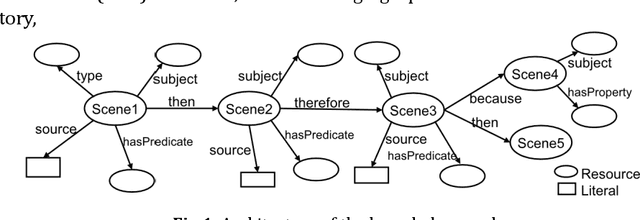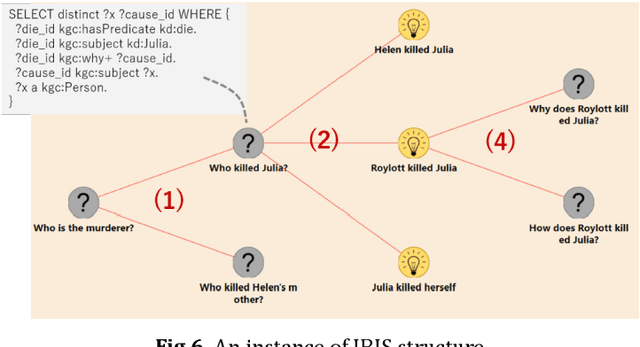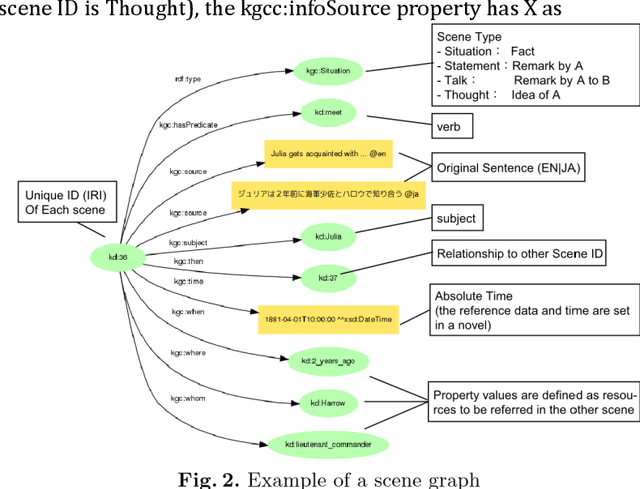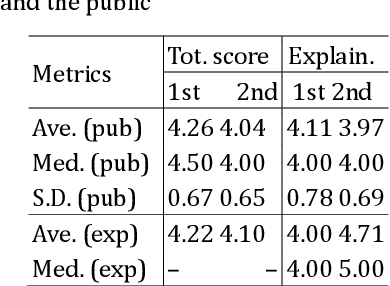Takahiro Kawamura
Synthetic Multimodal Dataset for Empowering Safety and Well-being in Home Environments
Jan 26, 2024Abstract:This paper presents a synthetic multimodal dataset of daily activities that fuses video data from a 3D virtual space simulator with knowledge graphs depicting the spatiotemporal context of the activities. The dataset is developed for the Knowledge Graph Reasoning Challenge for Social Issues (KGRC4SI), which focuses on identifying and addressing hazardous situations in the home environment. The dataset is available to the public as a valuable resource for researchers and practitioners developing innovative solutions recognizing human behaviors to enhance safety and well-being in
RDF-star2Vec: RDF-star Graph Embeddings for Data Mining
Dec 25, 2023Abstract:Knowledge Graphs (KGs) such as Resource Description Framework (RDF) data represent relationships between various entities through the structure of triples (<subject, predicate, object>). Knowledge graph embedding (KGE) is crucial in machine learning applications, specifically in node classification and link prediction tasks. KGE remains a vital research topic within the semantic web community. RDF-star introduces the concept of a quoted triple (QT), a specific form of triple employed either as the subject or object within another triple. Moreover, RDF-star permits a QT to act as compositional entities within another QT, thereby enabling the representation of recursive, hyper-relational KGs with nested structures. However, existing KGE models fail to adequately learn the semantics of QTs and entities, primarily because they do not account for RDF-star graphs containing multi-leveled nested QTs and QT-QT relationships. This study introduces RDF-star2Vec, a novel KGE model specifically designed for RDF-star graphs. RDF-star2Vec introduces graph walk techniques that enable probabilistic transitions between a QT and its compositional entities. Feature vectors for QTs, entities, and relations are derived from generated sequences through the structured skip-gram model. Additionally, we provide a dataset and a benchmarking framework for data mining tasks focused on complex RDF-star graphs. Evaluative experiments demonstrated that RDF-star2Vec yielded superior performance compared to recent extensions of RDF2Vec in various tasks including classification, clustering, entity relatedness, and QT similarity.
* 13 pages, 6 figures, and this paper has been accepted by IEEE Access
Report on the First Knowledge Graph Reasoning Challenge 2018 -- Toward the eXplainable AI System
Aug 22, 2019



Abstract:A new challenge for knowledge graph reasoning started in 2018. Deep learning has promoted the application of artificial intelligence (AI) techniques to a wide variety of social problems. Accordingly, being able to explain the reason for an AI decision is becoming important to ensure the secure and safe use of AI techniques. Thus, we, the Special Interest Group on Semantic Web and Ontology of the Japanese Society for AI, organized a challenge calling for techniques that reason and/or estimate which characters are criminals while providing a reasonable explanation based on an open knowledge graph of a well-known Sherlock Holmes mystery story. This paper presents a summary report of the first challenge held in 2018, including the knowledge graph construction, the techniques proposed for reasoning and/or estimation, the evaluation metrics, and the results. The first prize went to an approach that formalized the problem as a constraint satisfaction problem and solved it using a lightweight formal method; the second prize went to an approach that used SPARQL and rules; the best resource prize went to a submission that constructed word embedding of characters from all sentences of Sherlock Holmes novels; and the best idea prize went to a discussion multi-agents model. We conclude this paper with the plans and issues for the next challenge in 2019.
 Add to Chrome
Add to Chrome Add to Firefox
Add to Firefox Add to Edge
Add to Edge